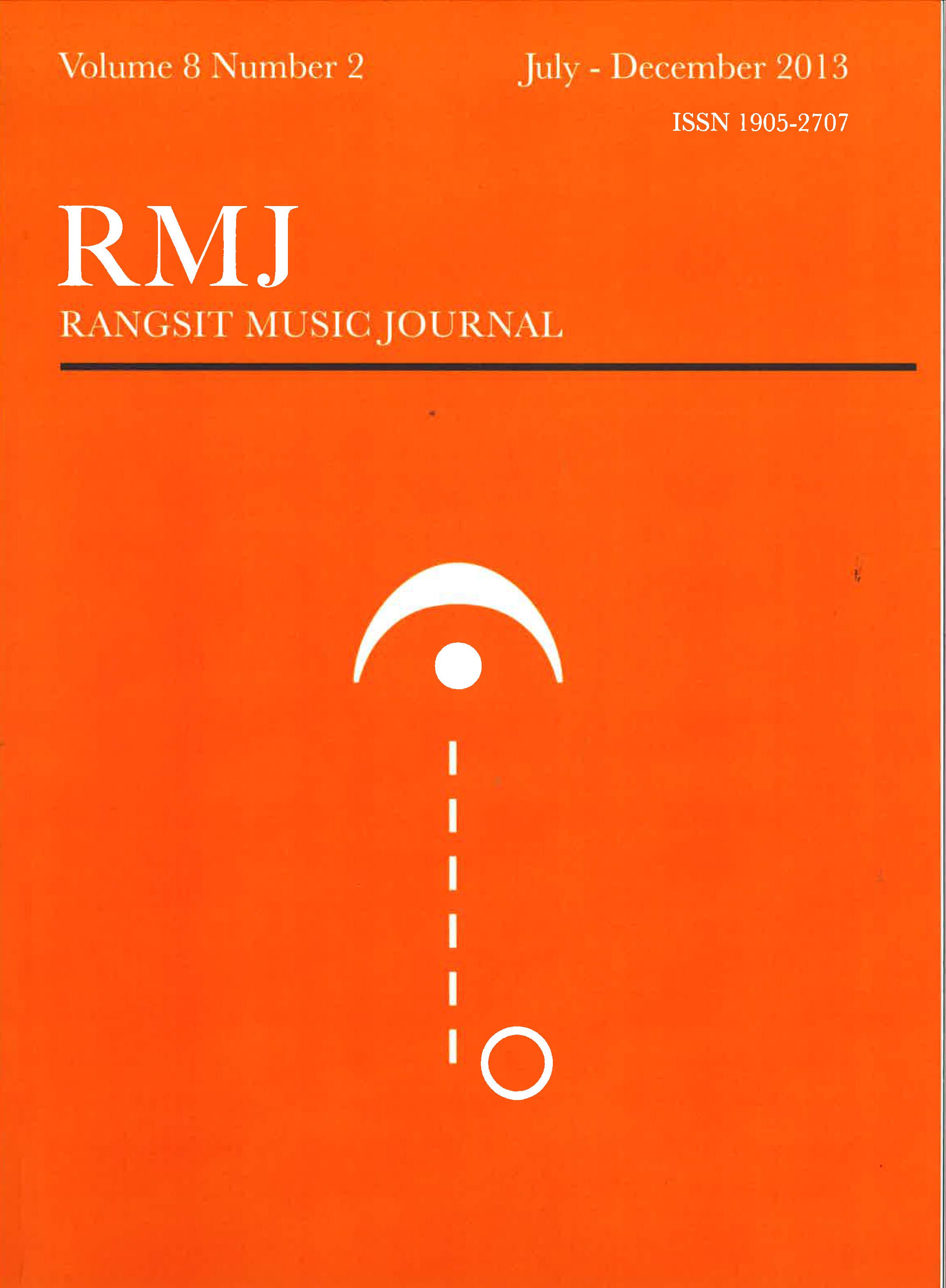Impulse for Jazz Orchestra
Abstract
The main objective of this article is a creative research in the form of music composition for a new chapter of jazz orchestra. The piece is a combination of jazz language, Non-Western atmosphere, and the use of technique of the 20th century classical music. Furthermore, the piece aims to be performed in public. The piece is based on the Third Stream and the 20th-century classical music. This composition is designed for the 17 jazz orchestral instruments--woodwind section, brass section, and rhythm section. Impulse for Jazz Orchestra is distinguished characteristics in each section. The whole composition, however, is based on tonality in the form of pitch centricity which mostly approaches by using pedal tone and ostinato. In addition, the 20th century classical music technique has been deliberately applied to this music composition together with its main theme of Non-Western atmosphere, imitating Islamic Chant. The composition, however, has also created enough space for instruments’ improvisation. The length of this piece is about 10 minutes. This work was performed at Thailand International Jazz Conference V, College of Music, Mahidol University. Moreover, it was also performed at Rangsit University Jazz Orchestra Monday Night Live Part III, Bangkok Thailand Cultural Center. The piece was broadcasted on the Dontri Kawee Silp TV Show, Thai PBS.
References
2. ณรงค์ฤทธิ์ ธรรมบุตร. การประพันธ์เพลงร่วมสมัย. กรุงเทพฯ: สำนักพิมพ์จุฬาลงกรณ์มหาวิทยาลัย, 2552.
3. ดานียา เจ๊ะสนิ. “การอะซานและอิกอมะฮุ” [ออนไลน์] เข้าถึงได้จาก: http://www.islamhouse.com/312041/th/th/ articles/, 12 พฤษภาคม 2556.
4. พลังพล ทรงไพบูลย์. “บทประพันธ์เพลงเบอร์มิวดาทรัยแองเกิลสำหรับวงดนตรีแจ๊สออร์เคสตรา.” รายงานการค้นคว้า อิสระปริญญาศิลปมหาบัณฑิต, สาขาวิชาดนตรี, วิทยาลัยดนตรี, บัณฑิตวิทยาลัย, มหาวิทยาลัยรังสิต, 2555.
5. ศักดิ์ศรี วงศ์ธราดล. ทฤษฏีดนตรีแจ๊สเล่ม 1. กรุงเทพฯ: ไอ.เอส. (มิวสิค) พับลิชชิ่ง, 2555.
6. อนันต์ ลือประดิษฐ์. Jazz: อิสรภาพทางดนตรีของมนุษยชาติ. พิมพ์ครั้งที่ 2. กรุงเทพฯ: เนชั่น มัลติมีเดีย กรุ๊ป จำกัด (มหาชน), 2545.
7. Belck, Scott. “Lickety Split: Modern Aspects of Composition and Orchestration in the Large Jazz Ensemble Compositions of Jim McNeely: An Analysis of Extra Credit, In the Wee Small Hours of the Morning, and Absolution.” DMA diss., University of Cincinnati, 2008.
8. Boras, Tom. Jazz Composition and Arranging. Belmont, CA: Thomson Schirmer, 2005.
9. Brekman, David. The Jazz Musician’s Guide to Creative Practicing. Petaluma, CA: Sher Music Co., 2007.
10. Damian, Jon. The Guitarist’s Guide to Composing and Improvising. Boston: Berklee Press, 2001.
11. Delamont, Gordon. Modern Harmonic Technique Volumes I & II. Delevan, NY: Kendor Music, Inc., 1965.
12. Dickreiter, Michael. Score Reading: A Key to the Music Experience. Pompton Plains, NJ: Amadeus Press, 2003.
13. Dobbins, Bill. The Contemporary Jazz Pianist. Jamestown, RI: Gamt Press, 1978.
14. Downes, Michael. “In the Current: Suite for Large Jazz Ensemble.” MA thesis, York University, 2008.
15. Dunscomb, Richard J., and Willie L. Hill Jr. Jazz Pedagogy: the Jazz Educator’s Handbook and Resource Guide. Miami: Warner Bros. Publications, 2006.
16. Ferris, Jean. America’s Musical Landscape. 4th ed. New York: McGraw-Hill, 2002.
17. Gridley, Mark C., and David Cutler. Jazz Styles: History and Analysis. 8th ed. New Jersey: Prentice Hall, 2003.
18. Haerle, Dan. The Jazz Language. Lebanon, IN: Studio P/R, 1980. Lawn, Richard J., and Jeffrey L. Hellmer. Jazz Theory and Practice. Los Angeles: Alfred Publishing Co., Inc., 1996.
19. Levin, Mark. The Jazz Theory Book. Petaluma, CA: Sher Music Co., 1995. Lowell, Dick, and Ken Pullig. Arranging for Large Jazz Ensemble. Boston: Berklee Press, 2003.
20. Mckinney Elizabeth. “Maria Scheider’s “Hang Gliding”: Dual Analyses for a Hybrid Musical Style.” MM thesis, Duquesne University, 2008.
21. Pease, Ted. Jazz Composition Theory and Practice. Boston: Berklee Press, 2003.
22. Pease, Ted, and Ken Pullig. Modern Jazz Voicings: Arranging for Small and Medium Ensembles. Boston: Berklee Press, 2001.
23. Porter, Lewis, Michael Ullman, and Edward Hazell. Jazz from Its Origins to the Present. Englewood Cliffs, NJ: Prentice-Hall. Inc., 1993.
24. Reich, Steve. Piano Phase. London: Universal Edition (London) Ltd., 1980.
25. Steinel, Mike. Building A Jazz Vocabulary: A Resource for Learning Jazz Improvisation. Milwaukee: Hal Leonard, 1995.
26. Sturm, Fred, ed. Maria Schneider: Jazz Orchestra Evanescence. Wieden, Vienna: UE Publishing Musikverlags GmbH, 1998.
27. Trakulhun, Wiboon. “Faithful to My Land.” DA diss., Ball State University, 2011.
28. Wright, Rayburn. Inside the Score: a Detailed Analysis of 8 Classic Jazz Ensemble Charts by Sammy Nestico, Thad Jones, And Bob Brookmeyer. Delevan, New York: Kendor Music, Inc., 1982.







